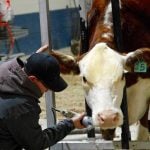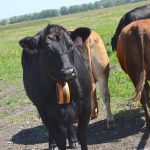Feedlot flies are often seen only as a nuisance, but the trouble they cause for cattle and producers can be serious.
Severe infestations can cause problems ranging from decreased cattle weight gains and economic loss to strained relations and conflicts with neighbors.
That’s why Agriculture Canada Lethbridge Research Centre livestock entomologist Kevin Floate said feedlot operators should take a systematic approach to manage fly populations this year.
Determine if pest species of flies are in the feedlot and whether the flies are an excessive irritant to cattle.
Read Also

Trump cuts off trade talks with Canada
(Reuters) – U.S. President Donald Trump said on Thursday that all trade talks with Canada were terminated following what he…
If necessary, implement a sustainable system to control the pests.
Stable flies and house flies are the two main species of pest flies found in feedlots.
Of the two, stable flies are the most economically harmful to the beef industry, causing up to $8 million in lost productivity annually in Alberta, according to estimates put together by Agriculture Canada.
“If you have flies on your cattle, and the cattle are obviously irritated by them, then you probably have a problem that warrants intervention,” Floate said.
“And where there are stable flies, there are house flies because they breed in the same areas. Although house flies are usually never more than just a nuisance, a fly infestation can lead to public relations problems with your neighbors.”
Stable flies and house flies are difficult to tell apart.
“Look carefully, however, and you’ll see the difference,” Floate said.
“Stable flies are blood feeders. Their mouthparts form a bayonet that projects out in front of the head and is used to bite the cattle. House flies are not blood feeders and do not have this bayonet.”
Although flies on cattle might indicate a problem, confirmation comes when the animals are visibly irritated.
So what’s the best option for controlling feedlot flies?
Floate suggested an integrated pest management approach with three components.
“The first step is sanitation, sanitation, sanitation,” he said.
“Flies breed in moist areas with rotting organic material. Producers need to walk around their pens, identify problem spots and clean them up.”
Trouble spots
Producers should learn to recognize breeding grounds.
- Areas beside standing water where hay, silage or manure is stored.
- Silage pits where water pools at the base and silage starts to rot.
- Spilled feed in alleys and around bunks left on the ground for long periods.
- Poorly managed manure piles or manure not piled in pens.
To alleviate problems
- Move feed and manure away from areas where water accumulates.
- Build a drainage trench to remove water from the base of silage pits.
- Spread spilled feed in alleys and around bunks to dry it out.
- Manage manure by piling or removing it from pens regularly.
Adult flies can be discouraged from congregating around feed pens by eliminating vertical, shady areas, such as standing patches of weeds, where they like to rest.
The prudent use of chemical control is the second step of an integrated pest management program.
If the fly problem is escalating in August or September, the best option is to spray, Floate said. When spraying, use restraint, he cautioned, because flies are developing resistance to some products and repeated spraying over several years will add to the problem.
Spray sites where adult flies congregate. Don’t spray where flies breed because the chemical will kill the beneficial bugs that feed on immature flies.
The third, and most experimental, part of integrated pest management is the use of biocontrol agents such as parasitic wasps.
They are small and don’t harm people or animals, but they search out fly pupae because that’s where they deposit their eggs.
Eggs hatch, the flies are killed and new wasps emerge to kill more flies.
Although they won’t eliminate a fly problem, parasitic wasps will help reduce fly populations.
The wasps can be purchased from commercial suppliers.
More details can be found on the Lethbridge centre’s website at: http://res.agr.ca/leth/scitech/kdf/intro.htm.














